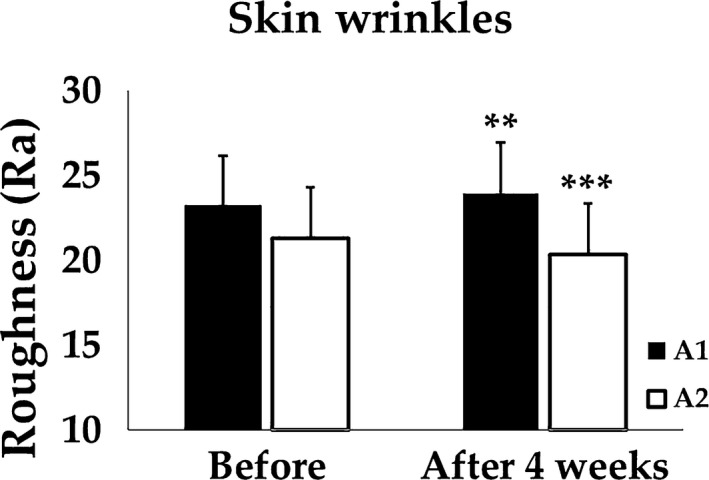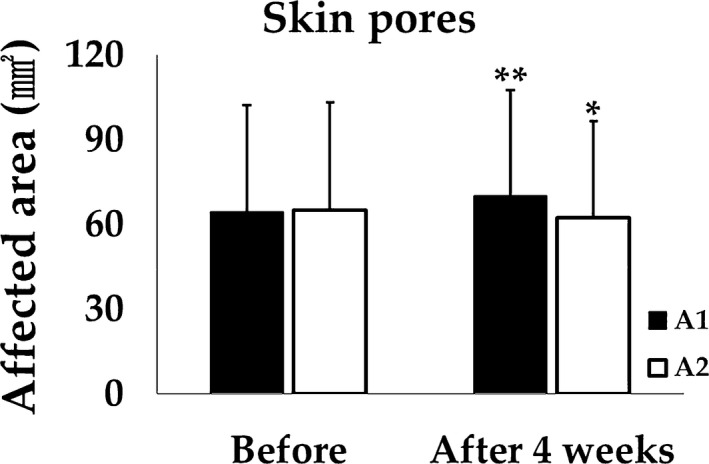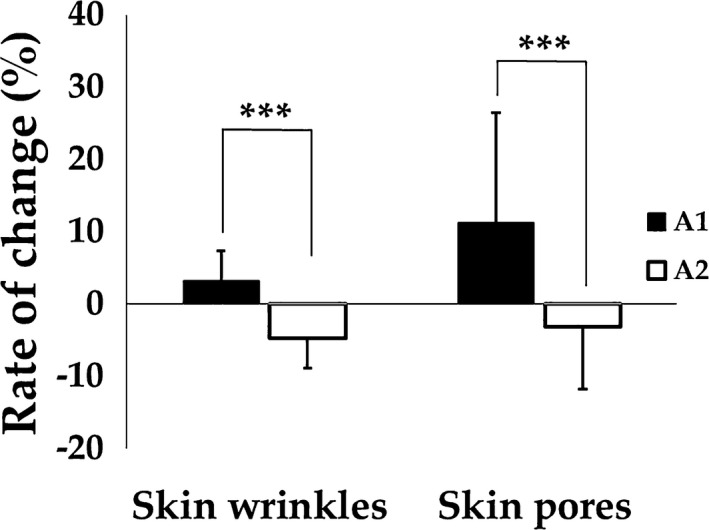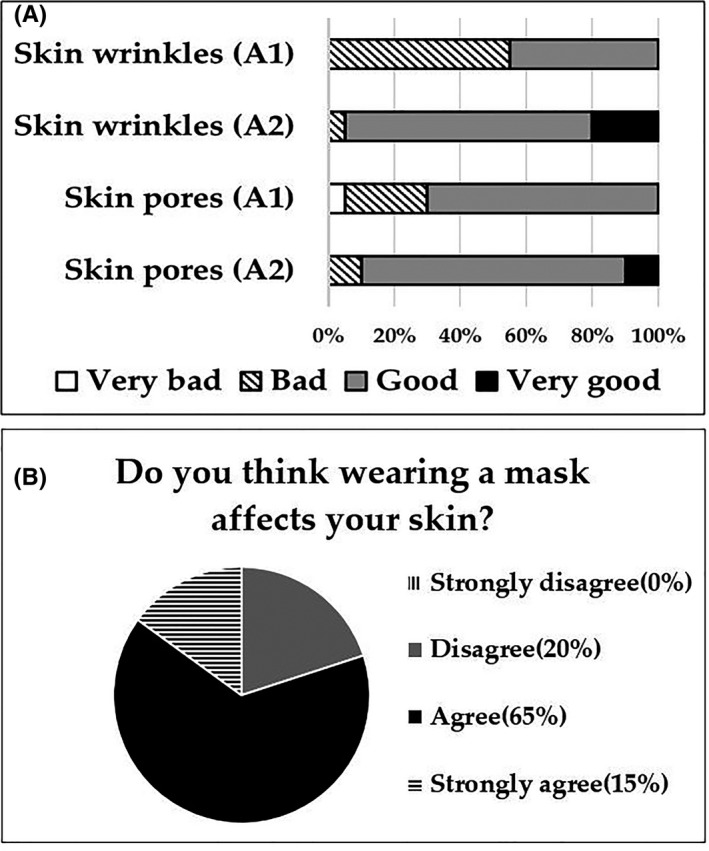Abstract
Background
The spread of COVID‐19 has made mask wear essential. Expecting that long‐term mask wear would change the characteristics of skin, this study investigated changes in skin wrinkles and pores caused by long‐term mask wear and whether or not use of moisturizers has an effect on any changes.
Materials and methods
The study participants were 20 women who were instructed to wear a mask for at least 6 hours a day for 4 weeks. Measurements of skin wrinkles and pores were obtained before and after the 4 weeks of mask wear. The effects of application of a moisturizer were assessed by applying moisturizer within the mask‐wearing area. They completed a questionnaire about skin changes at the end of the study period.
Results
After wearing the mask for 4 weeks, there was a significant increase in the skin wrinkles and pores; both variables decreased significantly in skin areas where a moisturizer had been applied. The results of the questionnaire‐based survey indicated the study participants considered that long‐term wearing of a mask had affected their skin.
Conclusion
Wearing a mask for extended periods increases skin wrinkles and pores and using a moisturizer when wearing the mask helps to reduce this problem.
Keywords: air pollution, COVID‐19, long‐term wear, masks, moisturizer, skin pores, wrinkles
1. INTRODUCTION
Since the declaration of the COVID‐19 pandemic by the World Health Organization on 11 March 2020, 1 COVID‐19 has continued to spread worldwide. The causative pathogen is severe acute respiratory syndrome coronavirus 2, which spreads by airborne transmission and causes severe respiratory disease. 2 Given the ability of masks to prevent infection, 3 mask wear is now recommended in many countries and has become a necessity in daily life. However, various adverse skin reactions to masks have been recognized during the ongoing COVID‐19 pandemic. Various mask‐related skin disorders have been reported, including erythema, papules, pustules, acne mechanica and contact dermatitis. 4 Many people, including healthcare workers, who wear masks for long periods of time, experience skin reactions, such as rash, itching, dry skin and acne. 5 , 6 , 7
There is an increasing perception that masks affect the skin 8 , 9 and a growing interest in how mask‐related skin damage can be avoided. A recent study found that short‐term mask wear affects the characteristics of the skin, 10 and it is likely that these effects become more pronounced when a mask is worn for longer periods. To the best of our knowledge, there has been no study of the effect of longer‐term mask wear on skin wrinkles and pores. Given the protracted nature of the present COVID‐19 pandemic, this study investigated changes in skin wrinkles and pores caused by long‐term mask wear and whether or not use of a moisturizer has an effect on any changes.
2. MATERIALS AND METHODS
2.1. Ethics approval
The study was approved by the OATC Institutional Review Board on 9 September 2020 and was carried out in accordance with the Declaration of Helsinki and Good Clinical Practice (approval number: 2018071702‐2009‐HR‐075‐010).
2.2. Study participants and treatment
The study participants were 20 healthy Korean women of mean age 50.10 (range 20‐60) years with no skin diseases or history of sensitive skin. The women were eligible for inclusion in the study if they were able to wear a mask for at least 6 hours a day for 4 weeks except when asleep and during mealtimes. The mask worn was the Dr Pepstory KF94 Fine Dust Protection Mask (EDL, Gyeonggi‐do, Korea). The study participants kept a written record of their daily mask wear during the 4‐week study period. All women signed an informed consent form after being provided with an explanation of the study.
2.3. Measurement of skin wrinkles
The skin wrinkles in the nasolabial folds on both sides of the face (part of the skin area covered by a mask) were counted using a PRIMOS lite device (LMI Technologies GmbH, Berlin, Germany). The severity of wrinkles in the nasolabial fold area was assessed by measurement of the skin roughness (Ra) value using the PRIMOS 5.7 software.
2.4. Measurement of skin pores
Skin pores were measured using an Antera 3D® CS system (Miravex, Dublin, Ireland). Measurements were obtained for the cheeks, both of which are covered when a mask is worn. The skin pore area(㎟) in the selected area was calculated after converting the images to “Pores_small” mode using the Antera 3D® software.
2.5. Assessment of effects of a moisturizer
The effect of application of a moisturizer on skin wrinkles and pores was investigated as follows. The mask‐wearing area was divided into a left side, where no moisturizer was applied (group A1), and a right side, to which a facial moisturizer was applied (group A2). The participants then wore their masks as directed. The moisturizer (Physiogel; Stiefel Laboratories, Sligo, Ireland) was applied to the right side of the face twice daily (morning and evening) for 4 weeks.
The study participants visited the Skin Clinical Trials Center before and after 4 weeks of mask wear. At each visit, the study measurements were obtained after 30 min of stabilization in a room with a controlled temperature of 22 ± 2°C and a relative humidity of 50 ± 10% and with avoidance of direct airflow and sunlight.
2.6. Questionnaire
At the second visit, all study participants completed a questionnaire about the effects of long‐term mask wear on skin wrinkles and pores. Each item was subjectively assessed on a 4‐point scale (1, very bad; 2, bad; 3, good; 4, very good). Participants answered to both of the questionnaires regarding the group A1 and A2. The questionnaire also asked the study participants whether or not they believed that long‐term mask wear would affect their skin. The women answered this question using a 4‐point scale (1, strongly disagree; 2, disagree; 3, agree; 4, strongly agree).
2.7. Statistical analysis
After the normality of the data was confirmed, changes in skin wrinkles and pores after long‐term mask wear were compared using the paired t test (a parametric method). Groups A1 and A2 were compared using the independent t test (also a parametric method). The results for skin wrinkles and pores are summarized as the mean and standard deviation. The results for each item on the questionnaire are shown as the percentage. All statistical analyses were performed using SPSS Statistics version 25 (IBM Corp., Armonk, NY, USA). A P‐value < 0.05 was considered statistically significant.
3. RESULTS
All 20 women (mean age, 50.10 ± 5.78 years) completed the study. The mask was worn for an average of 7.05 ± 0.73 hours per day during the 4‐week study period.
The Ra value for skin wrinkles increased by 3.21% in the A1 group after 4 weeks of wearing the mask (before, 23.24 ± 2.92; after, 23.97 ± 3.00) but decreased by 4.68% in the A2 group (before, 21.34 ± 2.99; after, 20.34 ± 3.01; Figure 1). The skin pore area increased by 11.21% in group A1 after 4 weeks of mask wear (before, 64.38 ± 37.77 mm2; after, 70.05 ± 38.15 mm2) and decreased by 3.10% in group A2 (before, 65.00 ± 37.34 mm2; after, 62.20 ± 34.45 mm2; Figure 2). The between‐group differences in skin roughness and skin pore area were statistically significant (Figure 3).
FIGURE 1.

Skin wrinkles were measured before and after 4 wk of mask wear. **P < .01, ***P < .001, after vs before 4 wk of mask wear. A1, facial skin area covered by the mask where no moisturizer was applied. A2, facial skin area covered by the mask where moisturizer was applied
FIGURE 2.

Skin pores were measured after 4 wk of wearing the mask. *P < .05, **P < .01, after vs before 4 wk of mask wear. A1, facial skin area covered by the mask where no moisturizer was applied. A2, facial skin area covered by the mask where moisturizer was applied
FIGURE 3.

Changes in skin wrinkles and pores after 4 wk of mask wear. ***P < .001, A1 vs A2. A1, facial skin area covered by the mask where no moisturizer was applied. A2, facial skin area covered by the mask where moisturizer was applied
According to the questionnaire results, 55.00% of women in group A1 and 5.00% of those in group A2 noted that their skin wrinkles had worsened during the study period while 30.00% and 10.00%, respectively, rated their skin pores to be larger. Eighty per cent of the study participants agreed with the statement that long‐term mask wear affected their skin (Figure 4).
FIGURE 4.

Results of a subjective questionnaire evaluation of changes in skin wrinkles and pores after 4 wk of mask wear. (A) Responses to questions about skin changes due to long‐term mask wear. (B) Responses to questioning about whether or not the study participants believed that long‐term mask wear would affect their skin (B). A1, facial skin area covered by the mask where no moisturizer was applied. A2, facial skin area covered by the mask where moisturizer was applied
4. DISCUSSION
Currently, in the absence of a cure for COVID‐19, the most effective preventative measures are wearing a mask, meticulous personal hygiene and social distancing. Moreover, with the increase in air pollutants, including fine, ultrafine and yellow dust, 11 long‐term mask wear, accompanied by changes in the characteristics of the skin, is likely to become more common in the future.
In this study, there was an increase in objective measurements of skin wrinkles and pores in areas of facial skin where no moisturizer was applied. Likely reasons for the increase in skin wrinkles are that the skin becomes rough in response to the friction created by long‐term mask wear and drying of the skin as a result of an increase in skin temperature in the area covered by the mask. 12 Another factor contributing to skin wrinkling could be the inability of the muscles around the mouth area to move freely. 13 The increase in skin pore area could be the result of an increase in the amount of sebum in the mask area, which decreases the elasticity of the skin, 10 , 14 and dryness of the skin resulting in the pores appearing to be more prominent. 15 In contrast, the measurements for skin wrinkles and pores decreased in areas where a moisturizer was applied, probably because the moisturizer prevented loss of skin elasticity by reducing the dryness of the skin caused by mask wear. There appears to be a relationship between skin moisture and elasticity in that both decrease with advancing age 16 and the fact that skin elasticity is known to influence skin wrinkles and pores. 16 , 17 However, in this study, as in others, it was difficult to confirm that the skin becomes dry and less elastic due to wearing a mask. One recent study found that skin moisture in the cheek area around the mouth decreased after mask wear but did not find a change in skin moisture in the chin area 18 ; however, the duration of mask wear was shorter in that study than in our study. Therefore, additional studies of the effects of long‐term mask wear on skin moisture and elasticity are required.
The subjective responses to our questionnaire were consistent with the findings of our objective assessment of skin wrinkling during mask wear in that wrinkling was worse in group A1 than in group A2. However, there was no significant between‐group difference in subjective assessment of skin pores status. Many women in both groups actually felt that their skin pores improved during mask wear. Changes in skin pores are difficult to detect with the naked eye, and there may be differences according to skin type. Therefore, future studies should include larger sample sizes and subjects with different skin types. Both the objective and subjective findings of our study indicate that wearing a mask has mixed effects on skin characteristics. More than half of the study participants considered that wearing a mask affects the skin. Therefore, more research is needed to determine both the positive and negative changes in the facial skin caused by mask wear.
5. CONCLUSION
In this study, we objectively assessed mask wear‐related skin wrinkles and pores and compared our findings with those of a subjective self‐reported questionnaire completed by the study participants. We identified objective increases in skin wrinkles and pores after long‐term wearing of a mask and that these effects are ameliorated by application of a moisturizer to the facial areas covered by the mask. More than half of the study participants considered that long‐term mask wear had affected their skin. In view of the ongoing COVID‐19 pandemic and increasing levels of air pollution, it is becoming increasingly important to understand the changes in skin characteristics associated with mask wear. The findings of this study may help cosmetics industry responding to these changes.
ACKNOWLEDGEMENTS
None.
Park M, Kim H, Kim S, et al. Changes in skin wrinkles and pores due to long‐term mask wear. Skin Res Technol. 2021;27:785–788. 10.1111/srt.13019
DATA AVAILABILITY STATEMENT
All data generated or analyzed during this study are include in this published article.
REFERENCES
- 1. Ragab D, Salah Eldin H, Taeimah M, Khattab R, Salem R. The COVID‐19 cytokine storm; what we know so far. Front Immunol. 2020;11:1446. [DOI] [PMC free article] [PubMed] [Google Scholar]
- 2. Zhai P, Ding Y, Wu X, Long J, Zhong Y, Li Y. The epidemiology, diagnosis and treatment of COVID‐19. Int J Antimicrob Agents. 2020;55:105955. [DOI] [PMC free article] [PubMed] [Google Scholar]
- 3. Chu DK, Akl EA, Duda S, et al. Physical distancing, face masks, and eye protection to prevent person‐to‐person transmission of SARS‐CoV‐2 and COVID‐19: a systematic review and meta‐analysis. Lancet. 2020;395:1973‐1987. [DOI] [PMC free article] [PubMed] [Google Scholar]
- 4. Das A, Kumar S, Sil A, Jafferany M. Skin changes attributed to protective measures against COVID‐19: a compilation. Dermatol Ther. 2020;33:e13796. [DOI] [PMC free article] [PubMed] [Google Scholar]
- 5. Kaihui HU, Fan J, Li X, et al. The adverse skin reactions of health care workers using personal protective equipment for COVID‐19. Medicine (Baltimore). 2020;99:24. [DOI] [PMC free article] [PubMed] [Google Scholar]
- 6. Zuo Y, Hua W, Luo Y, Li L. Skin reactions of N95 masks and medial masks among health care personnel: A self‐report questionnaire survey in China. Contact Dermatitis. 2020;83:145‐147. [DOI] [PMC free article] [PubMed] [Google Scholar]
- 7. Techasatian L, Lebsing S, Uppala R, et al. The effects of the face mask on the skin underneath: a prospective survey during the COVID‐19 pandemic. J Prim Care Community Health. 2020;11:2150132720966167. [DOI] [PMC free article] [PubMed] [Google Scholar]
- 8. Gheisari M, Araghi F, Moravvej H, Tabary M, Dadkhahfar S. Skin reactions to non‐glove personal protective equipment: an emerging issue in the COVID‐19 pandemic. J Eur Acad Dermatol Venereol. 2020;34:e297‐e298. [DOI] [PMC free article] [PubMed] [Google Scholar]
- 9. Jaremek A, Chodun W, Piechnik J, Nieradko‐Iwanicka B. The influence of wearing masks and gloves due to COVID‐19 pandemic on skin problems and skin care in students of Medical University in Lublin. J Educ Health Sport. 2020;10(11):82‐88. [Google Scholar]
- 10. Hua W, Zuo Y, Wan R, et al. Short‐term skin reactions following use of N95 respirators and medical masks. Contact Dermatitis. 2020;83:115‐121. [DOI] [PMC free article] [PubMed] [Google Scholar]
- 11. Kang D, Kim JE. Fine, ultrafine, and yellow dust: emerging health problems in Korea. J Korean Med Sci. 2014;29:621‐622. [DOI] [PMC free article] [PubMed] [Google Scholar]
- 12. Scarano A, Inchingolo F, Lorusso F. Facial skin temperature and discomfort when wearing protective face masks: thermal infrared imaging evaluation and hands moving the mask. Int J Environ Res Public Health. 2020;17:4624. [DOI] [PMC free article] [PubMed] [Google Scholar]
- 13. Lemperle G, Holmes RE, Cohen SR, Lemperle SM. A classification of facial wrinkles. Plast Reconstr Surg. 2001;108:1735‐1750. [DOI] [PubMed] [Google Scholar]
- 14. Hameed A, Akhtar N, Khan HMS, Asrar M. Skin sebum and skin elasticity: Major influencing factors for facial pores. J Cosmet Dermatol. 2019;18:1968‐1974. [DOI] [PubMed] [Google Scholar]
- 15. Duffy JA, Znaiden AP. Composition and method for visibly reducing the size of skin pores. U.S. Patent No 5,472,699. December 5, 1995.
- 16. Langton AK, Sherratt MJ, Griffiths CEM, Watson REB. A new wrinkle on old skin: the role of elastic fibres in skin ageing. Int J Cosmet Sci. 2010;32:330‐339. [DOI] [PubMed] [Google Scholar]
- 17. Kim BY, Choi JW, Park KC, Youn SW. Sebum, acne, skin elasticity, and gender difference–which is the major influencing factor for facial pores? Skin Res Technol. 2013;19:e45‐e53. [DOI] [PubMed] [Google Scholar]
- 18. Park SR, Han J, Yeon YM, Kang NY, Kim E. Effect of face mask on skin characteristics changes during the COVID‐19 pandemic. Skin Res Technol. 2020;00:1‐6. [DOI] [PMC free article] [PubMed] [Google Scholar]
Associated Data
This section collects any data citations, data availability statements, or supplementary materials included in this article.
Data Availability Statement
All data generated or analyzed during this study are include in this published article.


